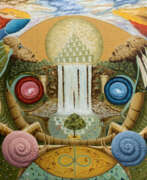Light art

Light art
Light art, a captivating and innovative art form, has evolved over the centuries to become a significant movement in the contemporary art world. Its inception can be traced back to the 17th century, when the concept of light began to take center stage in artworks. Renowned Baroque artists like Caravaggio mastered chiaroscuro, a technique that played with light and shadow to create dramatic atmospheres and depth in their works. This approach significantly influenced the Baroque style, evident in the masterpieces of Rubens and Rembrandt.
The Impressionist movement of the 1860s, spurred by the invention of portable tubed paint, marked a pivotal shift in how artists portrayed light. Impressionists such as Monet and Renoir focused on depicting light's natural variations and its influence on the environment. This movement saw artists experimenting with sunlight and its myriad color shades in outdoor settings.
In the 1930s, the evolution of light art took a revolutionary turn with artists beginning to use light not just as a subject, but as a medium itself. László Moholy-Nagy, a Hungarian artist and a professor at the Bauhaus School in Germany, is often credited as the first to create object-based light sculptures. His work, "Light Prop for an Electric Stage" (Light-Space Modulator), used projected color and white light to create shadow effects, thereby initiating a new approach to Lumino kinetic art within the Dada movement.
The 1960s witnessed the emergence of the Light and Space Movement, primarily in Los Angeles. This movement was led by artists like James Turrell, Eric Orr, Robert Irwin, Mary Corse, and Doug Wheeler, who experimented with natural light, artificial light, and various materials to enhance the viewer's sensory and psychological experiences. Turrell’s work, for instance, is known for its focus on the perceptual phenomena of light art, incorporating materials that juxtapose with light and volume.
Today, light art is a diverse field that encompasses multiple forms, including sculpture, installation, and performance. Contemporary artists continue to push the boundaries, using color, angles, shadows, and technology to create works that challenge our perception of the environment and space around us. Light art festivals and museums dedicated to this genre, like the Centre for International Light Art in Unna, Germany, and the Light Art Museum in Eindhoven, Netherlands, showcase the evolution and diversity of this art form.
For collectors, auctioneers, and art enthusiasts, light art represents an intriguing and transformative aspect of modern art. It offers a dynamic and interactive experience that transcends traditional art forms. If you are interested in exploring this fascinating genre further and staying informed about new developments and events in the world of light art, consider signing up for updates on exhibitions, sales, and auctions related to this innovative art movement.
| Country: | Belgium, Finland, France, Germany, Sweden, USA |
|---|---|
| Start of the period: | 1920 |

